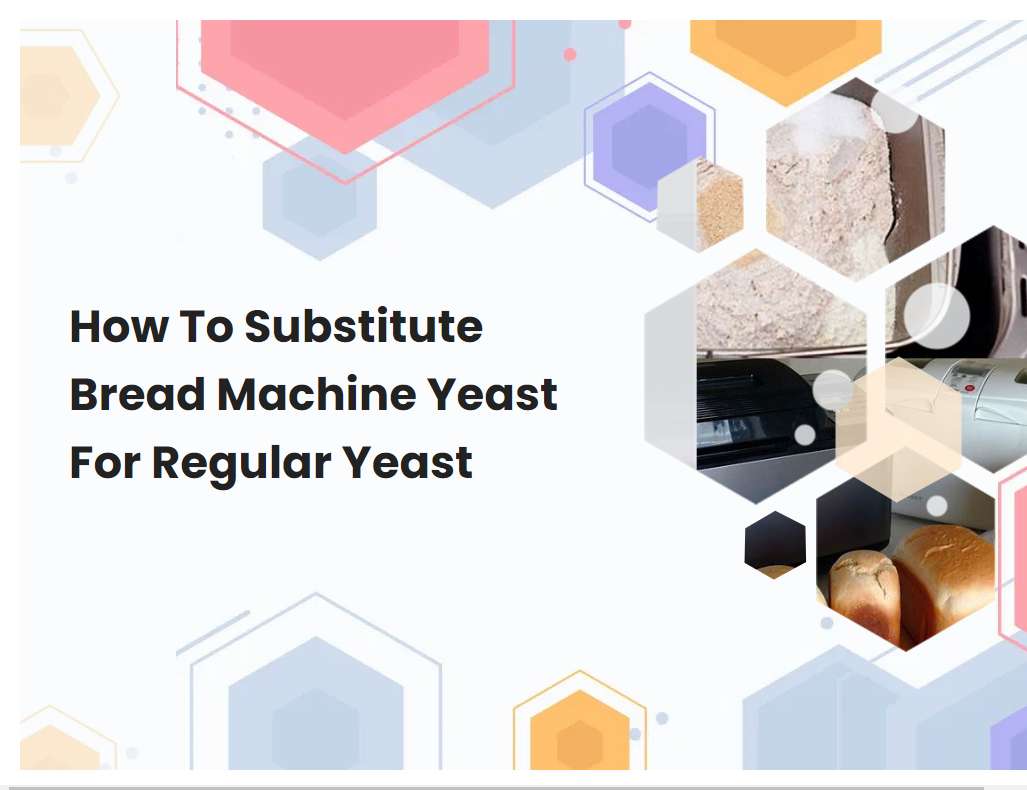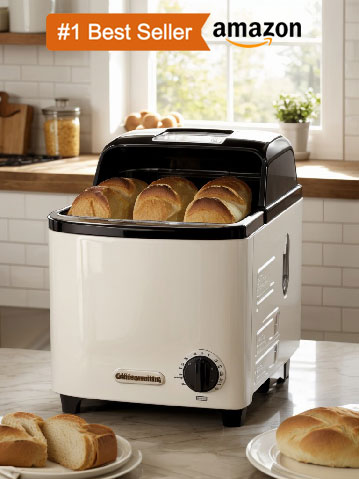How To Substitute Bread Machine Yeast For Regular Yeast
Yeast is a leavening agent used to make bread and other baked goods rise. It can be used in a bread machine or you can use regular yeast. Knowing how to substitute bread machine yeast for regular yeast can be a helpful skill in the kitchen. In this article, we will discuss how to make the substitution and the differences between the two types of yeast.

Bread machine yeast is a specific type of active dry yeast, which is specifically designed to be used in bread machines.
Bread machine yeast is a type of active dry yeast that is specially formulated for use in bread machines. It is a finer, more granulated, and higher-activity yeast than standard active dry yeast and is designed to be added directly to the dry ingredients in the bread machine pan. Bread machine yeast is designed to be fast-acting, so it starts working right away and helps to ensure that the dough rises quickly and evenly.
This type of yeast should not be confused with instant yeast, which is also sometimes called bread machine yeast. Bread machine yeast is also ideal for use in recipes that require a longer rise time, as it will remain active for an extended period of time. Bread machine yeast is especially useful for those who are new to baking, as it helps to ensure a successful result every time.
Bread machine yeast is a finer grind than regular active dry yeast and is meant to dissolve faster in the dough.
Bread machine yeast is a specially designed variety of dry yeast designed to work best with bread machines. It is a finer grind than the active dry yeast typically used in baking recipes, and it is specifically formulated to dissolve more quickly in the dough. The finer grind of the yeast allows it to disperse more evenly and rapidly throughout the dough, allowing for faster and more uniform rising.
Additionally, bread machine yeast is generally more tolerant of the varying temperatures that occur during the bread machine cycle, ensuring consistent results each time. While it can be used in recipes that do not call for a bread machine, it's important to note that it will not produce the same results as active dry yeast, and may require some experimentation to achieve satisfactory results.
See also: Philips Sense And Simplicity Bread Machine Bake Time
The ratio of regular active dry yeast to bread machine yeast is 1:1.
Regular active dry yeast and bread machine yeast are both types of yeast used in baking, but they differ in both the way they are used and the form they come in. Regular active dry yeast is a granulated form of yeast and is typically used when making traditional yeast-based doughs and baked goods. In contrast, bread machine yeast is a finer, more concentrated version of active dry yeast and is specifically designed for use with bread machines.
This special yeast is designed to work in shorter rising times and at higher temperatures, making it the preferred choice for quick-rise doughs. When using either type of yeast in baking, it is important to use the correct ratio, which is 1:1 for regular active dry yeast and bread machine yeast.
See also: How To Modify Bread Machine To Be Small Oven
Bread machine yeast should be added directly to the dry ingredients before adding any liquid.
Bread machine yeast should be added directly to the dry ingredients in a bread machine before any liquid is added. This is important because adding the yeast to the dry ingredients helps to ensure that it is evenly distributed throughout the dough. The yeast will then begin to activate in the presence of the liquid and the other ingredients, allowing for the dough to rise.
It is important to note that bread machine yeast should not be added directly to the liquid as this can cause clumping and make it difficult for the yeast to properly activate. Additionally, adding the yeast to the dry ingredients also helps to protect it against any heat that may be generated by pre-heating the liquid prior to adding it to the bread machine. Therefore, always be sure to add your bread machine yeast directly to the dry ingredients before adding any liquid.
See also: Can You Use Milk In Bread Machine
It is important to follow the instructions for the specific type of bread machine yeast that you are using as some may require different temperatures for proofing and rising times.
When using bread machine yeast, it is important to follow the instructions for the specific type of yeast. Different types of bread machine yeast may require different temperatures for proofing and rising times. For example, some bread machine yeasts need to be proofed in warm water (around 105-115°F) for 5-10 minutes before adding it to other ingredients.
Other bread machine yeasts may require a longer proofing time (20-30 minutes) in lukewarm water (around 80-90°F). Additionally, bread machine yeasts may require different rising times depending on the recipe and the type of yeast being used. Generally, bread machine yeasts need to rise between 45-60 minutes before baking. Following the instructions for the specific type of bread machine yeast will ensure that your bread turns out perfectly and tastes delicious.
See also: Rye Bread Bread Machine Dried Active Yeast
It is important to not add too much bread machine yeast as it can lead to over-proofing and an overly bitter flavor.
When using a bread machine, it is extremely important to pay attention to the amount of yeast used. Adding too much can lead to a variety of issues, the most common of which is over-proofing. This occurs when the dough becomes too large and dense, resulting in an overly bitter flavor.
The amount of yeast you should use will depend on the type and size of loaf you are making, as different amounts of yeast are needed for different types of bread. Generally, one teaspoon of active dry yeast or two and a half teaspoons of instant yeast are enough for one pound of flour, however more may be needed for larger loaves. It is best to follow the manufacturer's instructions for the exact amount needed for your recipe. Too little yeast will result in an underproofed loaf, while too much will lead to an overproofed loaf with a bitter flavor.
See also: How To Make Wheat Bread In A Bread Machine
It is important to follow the instructions for the specific type of bread that you are making as some recipes may require different types of yeast for different types of breads.
When it comes to making bread, it is essential to follow the instructions of the specific recipe you are using. Different types of breads may require different types of yeast, as well as other ingredients, in order to properly rise and bake. Yeast is a living organism that produces carbon dioxide when activated, causing the dough to rise.
Therefore, it is important to use the correct type of yeast for the particular bread recipe you are using. For example, breads that contain added sugar or fat, such as brioche or challah, will require a yeast that is more robust than the type used for leaner doughs, such as French bread. Additionally, you may need to adjust the amount of yeast depending on the type of bread you are making. For example, whole wheat breads may require a bit more yeast than white breads. Following the instructions and using the right type of yeast will ensure that your bread will turn out just right.
Regular active dry yeast can be used in a bread machine but it will take longer to rise and may require longer proofing times than what is suggested in the recipe.
Active dry yeast is a type of yeast that can be used in bread machines to make bread. Unlike instant yeast, which is pre-activated, active dry yeast needs to be hydrated and activated before being used in a recipe. To do this, the yeast should be mixed with warm water and a pinch of sugar and set aside for a few minutes until it becomes foamy.
Once this is done, it can be added directly to the other ingredients in the bread machine. Active dry yeast takes longer to rise than instant yeast and will require longer proofing times than what is suggested in the recipe. It may take up to an hour or more for the dough to double in size, so it's important to be patient. The result will be a flavorful and fragrant loaf of homemade bread.
Bread machine yeast should be stored in a cool, dry place and should be used before the expiration date printed on the package.
Bread machine yeast is an essential ingredient for baking delicious homemade breads. It should be stored in a cool, dry place to ensure it remains fresh and effective. Heat and moisture can cause the yeast to go bad and lose its ability to make dough rise.
It is important to check the expiration date printed on the package before using the yeast. If the date has passed, it is best to purchase a new package of bread machine yeast. Storing the yeast properly will help ensure that you get the most out of each package and create delicious, homemade breads every time.
Bread machine yeast should not be used in place of fresh or instant yeast in a recipe.
Using bread machine yeast in place of fresh or instant yeast in a recipe can have disastrous results. Bread machine yeast is specifically formulated to work in bread machines, which produce dough with a high moisture content. The higher moisture content requires a slower-acting yeast, which is why bread machine yeast works best in bread machines.
When used in recipes that don't call for bread machine yeast, the results can be unpredictable and unsatisfactory. Bread machine yeast is not as active as fresh or instant yeast, meaning it won't rise as quickly or produce the same texture or flavor as recipes that call for fresh or instant yeast. Furthermore, bread machine yeast should never be used in recipes that require multiple rises, such as those for croissants and other laminated doughs, because the dough won't rise properly. For best results, always use the type of yeast specified in the recipe.





